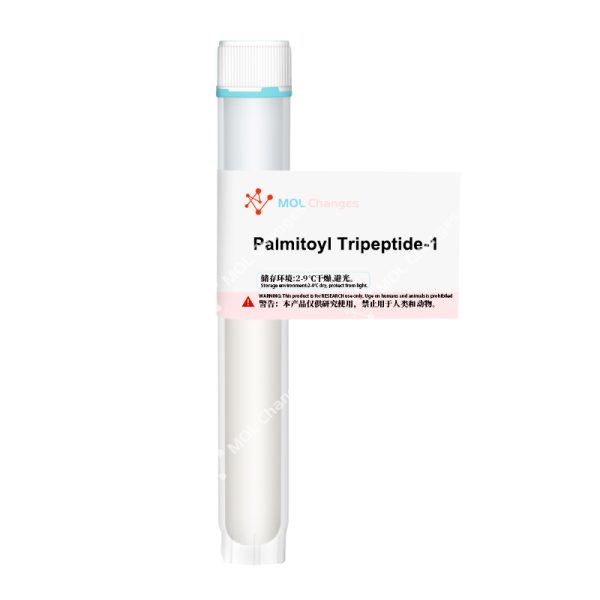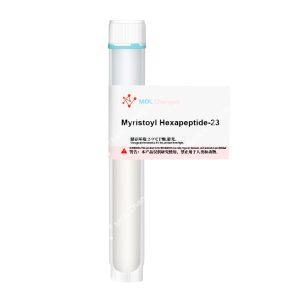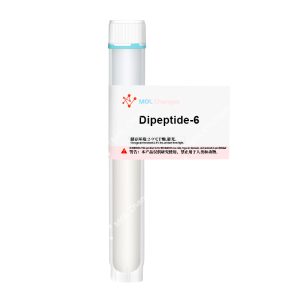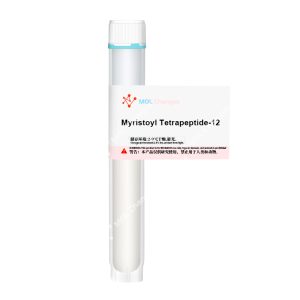Palmitoyl Tripeptide-1(Pal-GHK/Palmitoyl-GHK) is a derivative of GHK.
Chemically modifying GHK with palmitic acid – a 16-carbon fatty acid – forms this derivative.
The palmitic acid covalently attaches to the peptide; serving as a hydrophobic moiety, the primary objective being enhanced skin permeability.
序列
Pal-Gly-His-Lys
化学文摘社编号
147732-56-7
分子式
C30H54N6O5
分子量
578.79 g/mol
Research Of Palmitoyl Tripeptide-1
GHK occurs naturally within the human body and is widely regarded as a multifunctional bioregulator.
Stimulating collagen and elastin synthesis, promoting wound healing, anti-inflammatory and antioxidant effects are all attributed to it.
Poor skin permeability is the key challenge GHK faces when used as a topical active; small molecule peptides by nature are hydrophilic.
The outermost layer of the skin, the stratum corneum, creates a highly hydrophobic barrier (lipids being the main composition).
Effective penetration past this layer to reach dermal target sites is hindered, penetration being the limiting factor.
Modifying hydrophilic peptides with hydrophobic groups to increase skin permeability is the logical solution.
Palmitoyl Tripeptide-1 is the product of this strategy.
Covalent linking of palmitic acid (a saturated 16C fatty acid) to GHK achieves this.
Higher skin permeability and improved compatibility with the lipid environment of the stratum corneum is observed; biological activity of the peptide itself remains largely unchanged, while transdermal delivery is improved.
Palmitoyl Tripeptide-1 itself functions as a potent signaling molecule.
It mimics the natural signals generated during extracellular matrix (ECM) fragmentation; directly interacting with receptors on cell membranes, it significantly stimulates collagen type I synthesis.
Simultaneously, it stimulates glycosaminoglycan (GAG) synthesis – another structurally important component of the skin matrix – initiating repair and regenerative processes.
Consequently, clear anti-aging potential is demonstrated by Palmitoyl Tripeptide-1.
Studies have shown specifically collagen synthesis being stimulated in human fibroblast cultures, degradation of this collagen (following long-wave UV exposure) being prevented.
Palmitoyl Tripeptide-1 and its analogues (Palmitoyl Tetrapeptide-7, Palmitoyl Pentapeptide-4, etc.) are now well researched and incorporated into numerous high end skincare formulations.
Palmitoyl Tripeptide-1 is extensively used in cosmetics; superior skin permeability compared to GHK and comparable biological activity being the primary reasons for this.
Matrixyl 3000™ is a prime example – the two active ingredients being Palmitoyl Tripeptide-1 and the previously mentioned tetrapeptide, widespread anti-aging products utilizing this combination are commonplace.
Currently there is a lack of independent clinical studies evaluating the pure efficacy of Palmitoyl Tripeptide-1.
Complex formulations containing it are typically the subject of current research.
Market and regulatory acceptance of Palmitoyl Tripeptide-1 as a cosmetic active, however, is well established as a mature cosmetic ingredient.
COA
高效液相色谱法
MS









评价
目前还没有评价